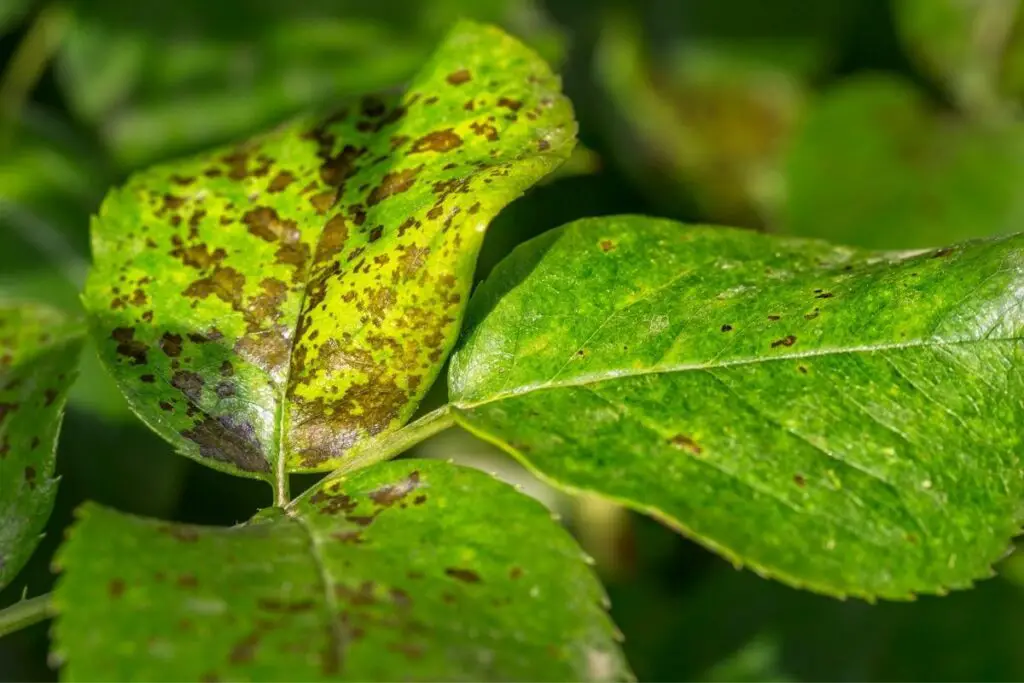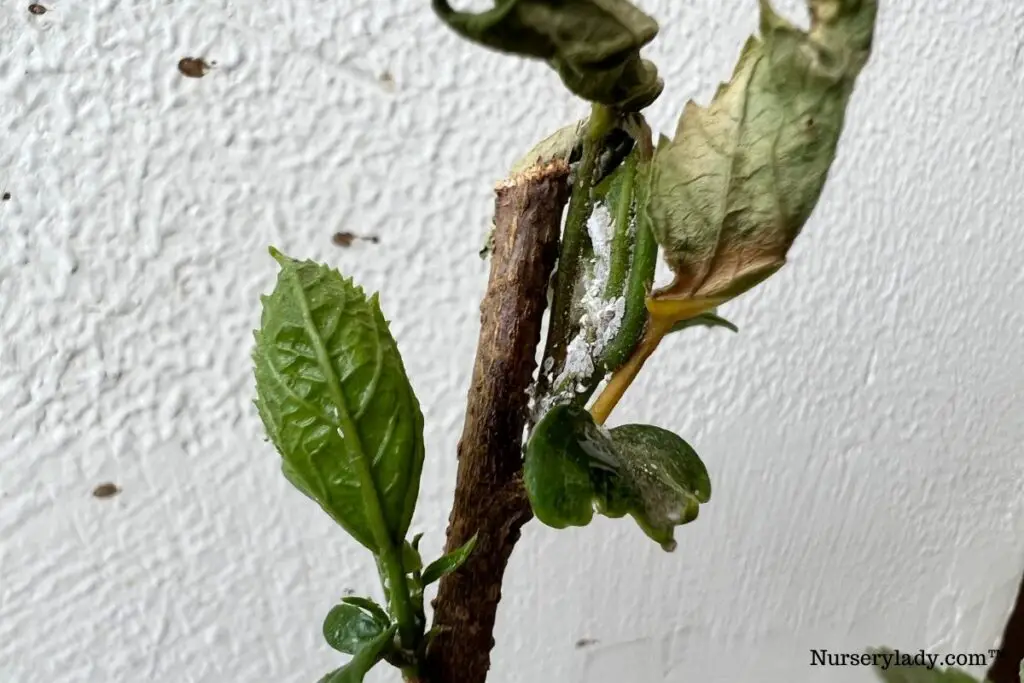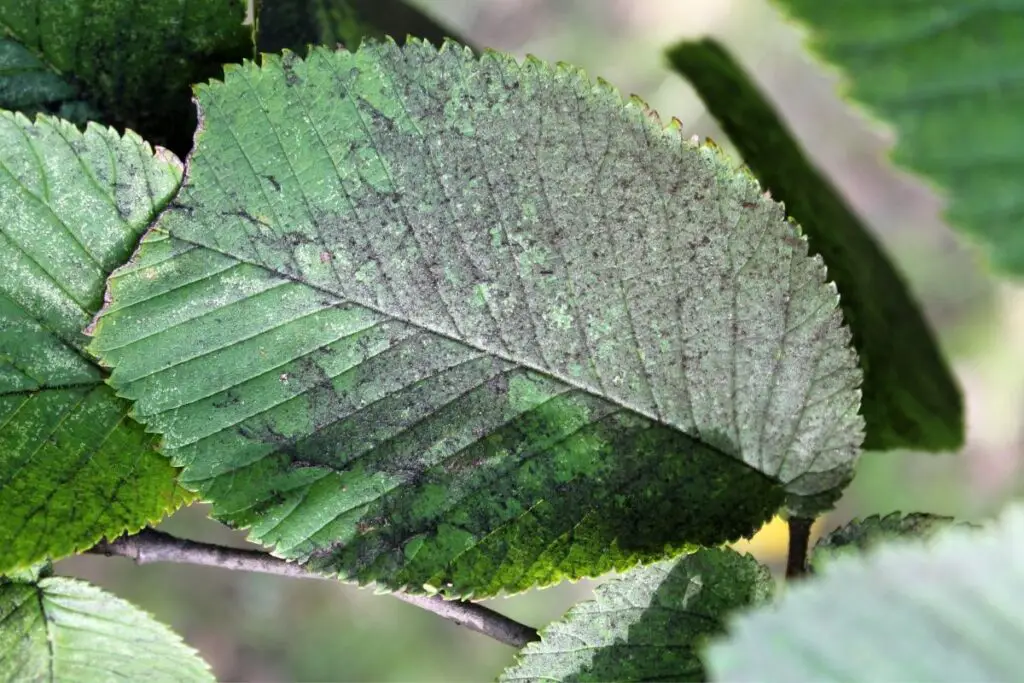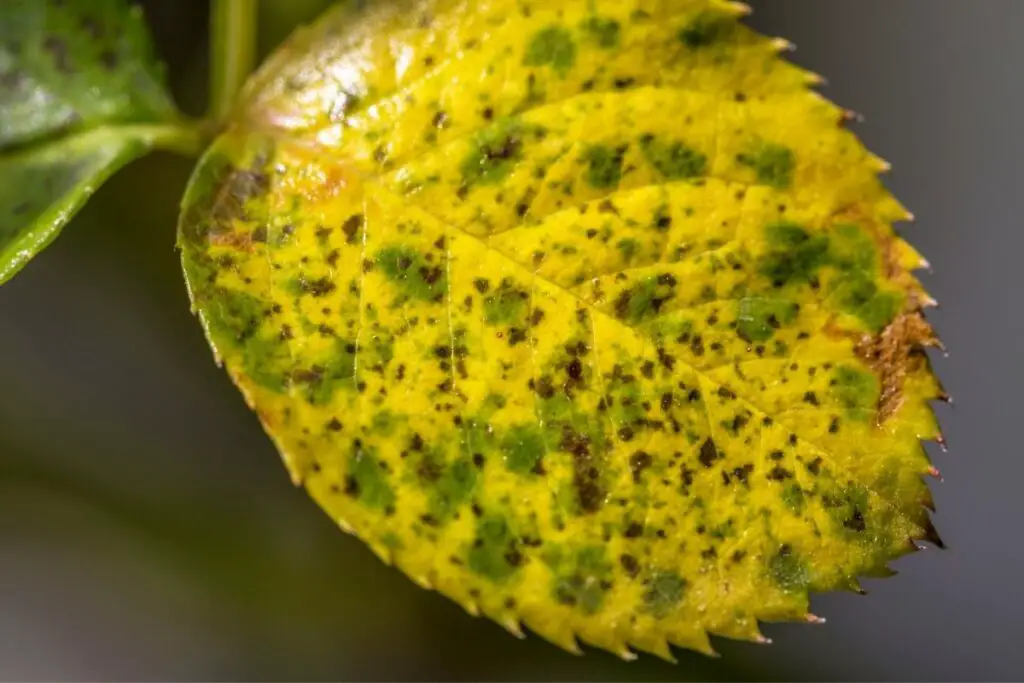If your Hibiscus plant leaves turn black or have black spots, you must understand that the plant is under stress. However, other than panicking about it, you should be focusing on proper treatment to restore the plant’s health.
Pests like black scales or aphids, fungal infections like gray mold, leaf spots, and sooty mold can cause black leaves and spots in the hibiscus plant. Take immediate steps to treat them by applying pesticides and fungicides. Stop creating unfavorable conditions that give rise to these issues.
You also need to remove the infected parts to prevent the spread of these infections. Follow this guide till the end to know what is wrong with your Hibiscus plant and how you can fix its black leaves.

Hibiscus leaves turning black or showing black spots
Black spots appear either due to pest infestation or fungal and bacterial growth.
When the spots spread, the leaves begin to turn black.
Black spots typically don’t hurt the plant much if you act early.
The fungal infections first strike the young leaves and stay there for some time.
It doesn’t spread much to other parts of the plant.
However, it will if you don’t treat the problem.
If the plant has sooty mold, the fungi feed on the pest secretions and not the plant’s tissues.
So the leaves don’t get damaged.
Now, let’s go through why Hibiscus leaves can turn black.
Pest infestation

Hibiscus plants can become prone to pest infestation if conditions are favorable.
The black spots you find under or over the leaves are probably black-colored pests.
Black spots appear on the leaves when the black scales and aphids attack the plant.
Black scales are round insects that remain attached to the twigs and under the leaves.
Since they don’t move much, the leaves have black spots all over.
Gardeners sometimes mistake it to be some disease.
Aphids are a common bug found in the Hibiscus plants.
They come in various colors.
When the black aphids attack the plant, the undersides of the leaves get filled with black spots.
They are aphids and not spots.
Some people, especially beginners, mistake them to be a disease.
These pests attack the plant when the moisture level is high and the sunlight is low.
When they infest your plant, the bugs starve the plant as they suck all the moisture and nutrients along with the sap.
So, it is important to get rid of the pests.
How do I eliminate bugs?
Black aphids: Aphids can reproduce very quickly.
So, it would be best to control their population when you spot them.
Remove the affected and damaged leaves from the plant to stop infection.
The best way to control the aphid population is with a systemic pesticide that can enter the xylem and phloem of the plant.
That is the place from where the bugs suck the sap.
- Use products with Imidacloprid. Let it get absorbed by the plant. When the bugs suck the sap, they absorb the chemical and die. Some products are Bayer Rose and Flower care and Bayer Advanced 3-in-1. The former product lasts for 3 months once applied. The latter will have to be applied every 2-3 weeks.
- Apply rosemary oil or insecticidal soap to coat the entire infestation area thoroughly. Concentrate on the underside of the leaves and the branches. For applying the oil or the soap, wait until the temperature is below 80°F. Use it every 10 to 14 days until the problem is resolved.
- Shower the plant forcefully to dislodge them from it. Since they move very slowly, they will take time to reach your plant and ultimately die out of starvation.
Black scales:
- Release natural predators on the soil bed like ladybugs and lacewings. You can buy them from the local market.
- Don’t use general pesticides if you use predators to kill the scales. Pesticides can reduce the population of predators.
- Use insecticidal soap for the soft scales.
- Let Hibiscus have full sunlight. Scales do not like the sunlight and will die due to the heat and the increased temperature.
- Prune the heavily affected leaves and branches. It will also let the plant have some more air and light. The heat and light will kill the young scales.
Looking for gardening supplies? We have tested 100's of products before recommending them to you guys. Check out our best pick below:
| Image | Gardening Supplies | Best Price? |
|---|---|---|
 Top
Top Top
Top | Raised Garden Bed Kit | Check On Amazon |
 | XLUX Soil Moisture Meter, Plant Water Monitor, Soil Hygrometer Sensor for Gardening, Farming, Indoor and Outdoor Plants, No Batteries Required | No Results |
 Top
Top Top
Top | 82 Pcs Garden Tools Set and Extra Succulent Tools Set | Check On Amazon |
 | Joeys Garden Expandable Garden Hose with 8 Function Hose Nozzle, Lightweight Anti-Kink Flexible Garden Hoses, Extra Strength Fabric with Double Latex Core, (50 FT, Black) | No Results |
 Top
Top Top
Top | Dual Chamber Compost Tumbler | Check On Amazon |
 Top
Top Top
Top | Sunnyglade Plant Stakes | Check On Amazon |
 Top
Top Top
Top | Organic Cold Pressed Neem Seed Oil | Check On Amazon |
 Top
Top Top
Top | Mighty Mint Gallon :-Insect and Pest Control Peppermint Oil | Check On Amazon |
 Top
Top Top
Top | Scotts DiseaseEx Lawn Fungicide | Check On Amazon |
 Top
Top Top
Top | Jacks Classic 20-20-20 All Purpose Fertilizer | Check On Amazon |
 Top
Top Top
Top | 30,000 Seeds Pollinator Attracting Wildflower Mixture | Check On Amazon |
 Top
Top Top
Top | Survival Vegetable Seeds Garden Kit-Over 16,000 Seeds | Check On Amazon |
Sooty mold

The aphids and scales are sap-sucking insects.
They suck the plant sap and release it in the form of honeydew.
This sticky substance further attracts a black fungus called sooty mold.
The fungus will spread over the leaves where honeydew is present and turn the leaves black.
The mold is usually a crusty coating over the green leaves.
The fungus feeds on the honeydew secreted by the bugs.
How can I clean sooty mold from the plant?
Sooty mold doesn’t kill your plant, especially the well-developed plants.
But it covers the leaves and blocks photosynthesis.
To remove sooty mold:
- First, control the pest infestation (explained in the previous point). It will reduce the honeydew on which the fungus feeds.
- You don’t need to use any fungicides. Once the bug problem is solved, the fungus will disappear. Fungicide may kill the fungus but won’t clean the black coating.
- Use soap and water to clean the coating. Add one tablespoon of liquid detergent to one gallon of water. Shake well and spray the mixture on the coated parts. Wash it off with a strong blast of water after 15 minutes to clean the leaves. Repeat this several times.
Gray mold
Gray mold is another fungal disease in the Hibiscus plants that causes black spots on the leaves and flowers.
The disease occurs when the plant has high moisture levels during the spring and summer, and the temperature is around 60 degrees.
It enters the plant through the open wounds mistakenly caused during pruning or transplanting.
The black spots are called sclerotia.
Control and prevention:
- Remove the plant’s dull and blighted leaves and flowers to prevent the fungus from spreading.
- If your Hibiscus plant is in a container, maintain a distance of at least 2 to 6 inches from them to stop spreading. Increase the air circulation. Adequate airflow will help dry out the plant if it is wet. Letting the plant dry will stop spreading the infection.
- Use a fungicide to kill the fungus. Try the products that are specifically made for Hibiscus plants only. Always abide by the instructions mentioned on the label.
- You can use a premixed, multipurpose fungicide having chlorothalonil. Don’t touch the plant until the product dries. Don’t use the fungicide if the weather is windy, rainy, or there are chances of rain within 24 hours.
- Avoid overhead watering or regular misting. The fungus enjoys damp conditions.
- Avoid using wet mulches.
- Remove the dead leaves, plants, and debris from around the plant to prevent them from overwintering and staying in the plant.
Leaf spot disease

Leaf spot disease (Black Spot) causes worrying black dots on the surface of the Hibiscus leaves.
But the good news is the spot goes off once the plant returns to its good health.
It does harm the plant but not as much as the other issues.
The disease causes black spots, reduced photosynthesis, stunted growth, and increased vulnerability to pests and diseases.
How can I control the disease?
The fungus dies when the temperature becomes warm and dry, and the infected leaves fall from the plant.
The spots disappear from the less affected leaves.
If your region stays wet most of the time, trim off the affected leaves to stop spreading.
- Clear the fallen leaves around the plant to avoid re-infection.
- Spray the leaves with an anti-microbial fungicide, for example, neem oil or Bayer Advanced 3-in-1. It will also make sure the fungus doesn’t attack any other plant.
- Improve air circulation by pruning some branches and leaves. Good airflow won’t let the fungus stay longer.
- Water the plant at the base and not on the leaves.
- Avoid fertilizing the plant while they are suffering from the disease.
Bacterial Leaf spot

Also called Pseudomonas Cichorii, the Bacterial Leaf spot is another disease.
It attacks the plant when the weather is wet and rainy.
It gets spread by the splashing of water.
The leaves will have black lesions all over.
How do I fix the problem?
- Remove the debris and other fallen leaves from the base of the plant.
- Trim off the worst-affected leaves and branches.
- Avoid overhead watering and let the plant have enough air circulation to dry the soil.
- Don’t overwater the plant and use well-drained soil.
How do I take care of the Hibiscus plant?
To avoid the problems discussed earlier in this article, you need to take proper care of the plant and observe its daily reactions.
Let’s learn about the care tips in brief:
| Factor | Care Tips |
|---|---|
| Sunlight | Letting Hibiscus have enough sunlight will keep the pests and fungus at bay. Since most infestation causes due to prolonged dampness, 6 to 8 hours of sunlight will not let the Hibiscus become prone to diseases. |
| Water | The pests and fungi enjoy wet soil. So, you need to water the plant only when the top 1 to 2 inches of the soil have dried up. Use a moisture meter to understand the moisture level. The plant is ready to take water if the result is within 1-3. Avoid overhead watering. Always water the soil at the plant base. |
| Soil | Sometimes, poor soil drainage will give the same results as overwatering. Use well-drained soil to keep Hibiscus healthy. |
| Fertilizer | Feed Hibiscus every 2 weeks with liquid fertilizers for optimal growth throughout the growing season. Avoid in winters. |
| Air circulation | Make sure the plant receives good air circulation. If you want to plant multiple Hibiscus or some Hibiscus companions, keep a space of about 2 to 4 inches in between. |
| Pruning | It allows the plant to have more air circulation, especially if the plant is extremely crowded. Good air circulation helps dry the soil and pass away the spores from the plant. |
| Temperature | Hibiscus requires a temperature ranging from 65-75°F. Sometimes, infections occur when the temperature is 60°F and the weather is rainy. Letting the plant have enough sunlight and using well-drained soil can keep the fungus from developing. |
| Humidity | Hibiscus needs high humidity. Along with high humidity, ensure airflow. |
| Mist with Neem oil | Misting the plant with neem oil every 15 days or once a month can keep the Hibiscus plants safe from pest infestation and fungal growth. Even if the plant is recently affected by any pest or fungus, neem oil can help it fight and stop the infestation from spreading. |
| Mulch | Mulching the soil bed every year can help increase the nutrition and maintain proper humidity. But don’t use wet mulches. |
| Maintain hygiene | Cleanliness and hygiene prevent fungal diseases from appearing and spreading. Always remove the fallen leaves from the plant base before the rain and fall. Throw them away from the garden or burn them. Never use them for compost. |
Final thoughts
Hibiscus having black leaves or black spots can be harmless or harmful. It depends on the problem your plant is facing. Whatever the situation is, you should never ignore the problem.
Identify the real cause behind black leaves or spots and take immediate steps to fix the issue. Avoid creating unfavorable conditions that promote the problem to develop and spread.
Proper sunlight, watering, well-drained soil, air circulation, and pruning are a few basic things that can keep pests and diseases away from the plant. Monthly usage of neem oil helps to fight the infestation early.
Reference: Wikipedia, ASPCA, Louisiana State University Agricultural Center, American Society for Horticultural Science, Tropical Hibiscus by Texas A&M University, Sciencedirect.
